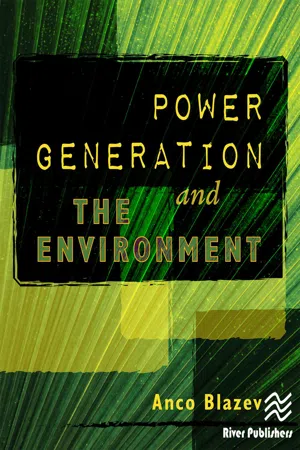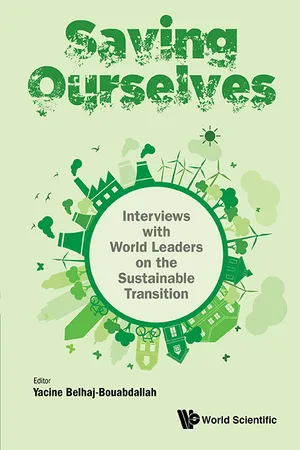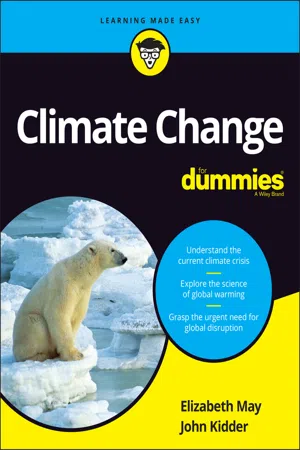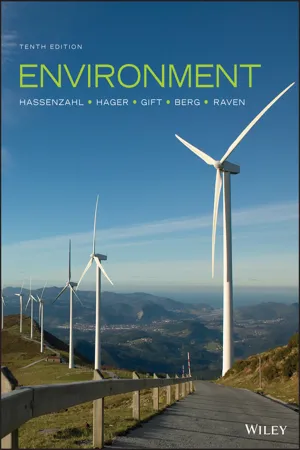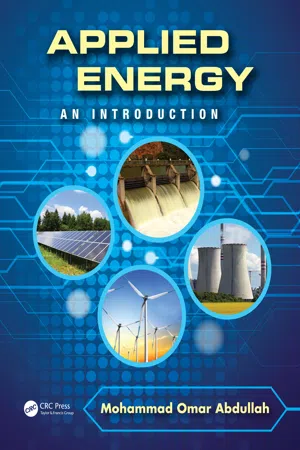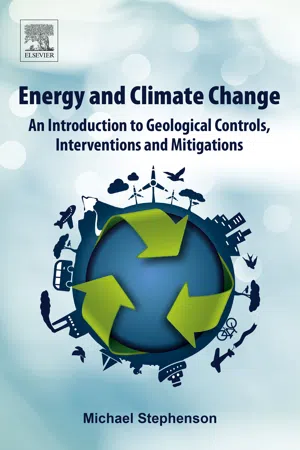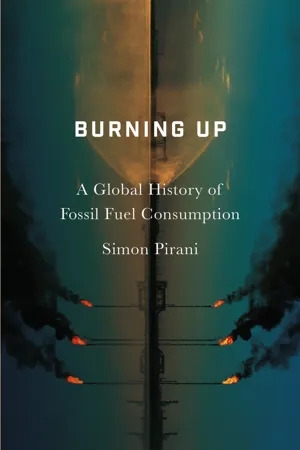Geography
Burning Fossil Fuels
Burning fossil fuels refers to the process of extracting and combusting non-renewable resources such as coal, oil, and natural gas to generate energy. This process releases carbon dioxide and other greenhouse gases into the atmosphere, contributing to global warming and climate change. The environmental impact of burning fossil fuels has led to a growing emphasis on transitioning to renewable energy sources.
Written by Perlego with AI-assistance
Related key terms
1 of 5
12 Key excerpts on "Burning Fossil Fuels"
- eBook - PDF
- Rainer Roldan Fiscal(Author)
- 2020(Publication Date)
- Arcler Press(Publisher)
The chapter also explains the types and formation of fossil fuels. It also tries to explain how fossil fuels are extracted from the ground. It also explains that fossil fuel extraction can also impact climate change by heating Earth from within. In addition, it also throws some light on conventional vs. unconventional oil. The concept of shale oil and gas is also explained. The refining of crude oil is also discussed in this chapter. The various processes involved in the refining of crude oil are also discussed in this chapter. Some of these processes are fractional distillation, vacuum distillation, cracking, solvent treating, solvent dewaxing, and thermal cracking. Moreover, the refining of natural gas is also discussed. In the end, how carbon is captured and stored is discussed in detail. 2.1. INTRODUCTION Fossil fuels are broader terms that entail hydrocarbons, primarily coal, natural gas, or fuel oil, created from the remains of dead animals and plants. In a general way, the term fossil fuel also involves hydrocarbon comprising natural resources that are not derived from plant or animal sources. Sometimes, these are also referred as mineral fuels. The significant rise in the use of fossil fuels has made it possible for large-scale industrial development and chiefly supplanted water-driven mills, as well as the burning of peat or wood for heat. In general, fossil fuel refers to a term for buried combustible geologic deposits especially of organic materials, produced from decayed animals and plants that have been transformed to coal, crude oil, heavy oils or natural gas by exposure to pressure and heat in the crust of earth over hundreds of millions of years. It is important to note that human activity contributed heavily for the burning of fossil fuels which is the main cause of emissions of CO 2 that is responsible for forming various greenhouse gases (GHGs), allowing radiative forcing and contributing to global warming. - eBook - PDF
- Anco S. Blazev(Author)
- 2021(Publication Date)
- River Publishers(Publisher)
In economic terms, pollution from fossil fuels is re-garded as a negative externality. Taxation is considered one way to make societal costs explicit, in order to “in-ternalize” the cost of pollution. This aims to make fos-sil fuels more expensive, thereby reducing their use and the amount of pollution associated with them, along with raising the funds necessary to counteract these factors. Energy and Environme nt Timelin e It is easy to see in Figure 2-5 that as things are go-ing—and there is no ch ange in sig ht—fossils will be de-pleted by the end of this century (and some of them even sooner), while energy use increases with the increase in Earth’s population. As the demand for energy increases, more coal, oil, and gas are burned, in turn creating more and new environmental issues. Burning coal, oil, and gas gives us comfort, technical and economic progress, while at the same time causing global warming and other harmful effects which are pos-ing great threats to the environment. The dangers seem to be growing greater for the future as we intensify coal, oil and gas burning. What are the plusses and minuses of these process and their consequences? This is what we aim to look at in detail in this text. Now we will take a very close look at the major en-ergy sources—coal, crude oil, natural gas, and nuclear power—and the related processes of their location, ex-traction, transport, refining, burning, energy transforma -tion, and use. THE FOSSIL FUELS Coal, crude oil, and natural gas are the primary en-ergy sources, used in over 85% of energy generation in the world. There are other fossil products, such as peat and bitumen that are also used for power generation, consumer goods, and other applications such as paving roads, but coal, oil and natural gas are by far the domi-nant fossil fuels today. Coal consists largely of carbon, although lower grades contain significant quantities of hydrocarbons and other contaminants such as sulfur and mercury. - eBook - PDF
- Douglas P. Heller, Carl H. Snyder(Authors)
- 2015(Publication Date)
- Wiley(Publisher)
the fossil fuels that power the farm equipment, factories, and trucks we use to produce it, process it, and bring it to market. It shouldn’t surprise us then, that a nation’s consumption of fossil fuels reflects its level of economic activity. 4 Energy and Society T hroughout the world, fossil fuels provide the energy that supports our modern lives. We use these fuels for transporting people and goods, as well as for pro- viding electricity and heat to our homes, buildings, and factories. Even the food we eat would be scarce if not for ª 4LJQ /BMM$PSCJT CHAPTER OUTLINE 4.1 Energy and Its Uses 90 What is energy? How is energy used by society? • Defining Energy • Uses of Energy 4.2 Fossil Fuels 93 What are fossil fuels, and why are they vital to society? • Types of Fossil Fuels • Combustion of Fossil Fuels 4.3 Petroleum Refining and Gasoline 98 What is petroleum refining? What is gasoline made of, and what does its octane rating represent? • The Internal Combustion Engine • Petroleum Refining • Gasoline 4.4 Fossil Fuels and the Carbon Cycle 106 What is the carbon cycle? How does Burning Fossil Fuels impact the carbon cycle? • Photosynthesis and Cellular Respiration • The Carbon Cycle 4.5 Greenhouse Gases and Climate Change 108 What are greenhouse gases, how do they affect the environment, and why are they a cause for concern? • The Greenhouse Effect • Climate Change 4.6 Energy for the Future 113 How can alternative energies meet future energy demand? How can we reduce the environmental impacts of carbon-based fuels? • Alternative Energies • Carbon-Based fuels 89 However, the burning of fossil fuels has an effect on the environment, releasing carbon dioxide gas into Earth’s atmosphere. The accumulation of this gas is affecting our climate, creating changes on a global scale. Scientists today are working to develop alternatives to fossil fuels to preserve our modern society without lead- ing to catastrophic climate changes. - eBook - PDF
Saving Ourselves: Interviews With World Leaders On The Sustainable Transition
Interviews with World Leaders on the Sustainable Transition
- Yacine Belhaj-bouabdallah(Author)
- 2017(Publication Date)
- WS PROFESSIONAL(Publisher)
31 Chapter 2 Fossil Fuels Over the past two centuries, our societies have been powered by fossil fuels. These sources, such as oil, coal and natural gas, were easy to extract and convert into usable energy. Despite catalysing great human progress and innovation, this has had adverse environmental effects. Extracting fossil fuels from the ground often risks contaminating nearby ecosystems and water sources, while consuming them releases CO 2 , which accumulates in the atmos-phere. The latter consequence is a source of great concern as it is one of the main causes of climate change, and because we consume fossil fuels at a rate greater than the Earth can sustain, the presence of CO 2 in our atmosphere has been raised to a level not seen in 3 million years. v This is especially worrying because human civilisation has devel-oped benefiting from a relatively stable climate over the past 10,000 years, and because the consequences of future climate change on our societies imply important risks. This is why governments are focusing their efforts on reducing CO 2 emissions both by promoting carbon-efficient technologies and transitioning to cleaner forms of energy. In what ways is the increased concentration of CO 2 in the atmosphere detrimental to us and to the environment? Adding CO 2 to the atmosphere interferes with the natural carbon cycle. The atmosphere, biosphere and oceans are in close contact with 32 Saving Ourselves: Interviews with World Leaders on the Sustainable Transition each other. So, some of the carbon will redistribute itself between these reservoirs. While the surface ocean and the biosphere tend to react fast, the deep ocean will take up to a 1,000 years to equilibrate with the surface of the planet. These reservoirs comprise the mobile carbon pool. Beyond these reservoirs, a large amount of carbon is tied up in the soil and in mineral carbonates. - eBook - PDF
- Elizabeth May, John Kidder(Authors)
- 2022(Publication Date)
- For Dummies(Publisher)
Although many of these plants were very different from anything known about today, they sucked up carbon dioxide from the atmosphere and gave off oxygen, like all plants still do. When fossil fuels are burned for energy, those fuels release their carbon, in the form of carbon dioxide and other gases that these ancient plants stored. (For more on why releasing carbon dioxide into the atmosphere is problematic, refer to Chapter 2.) GHGs are released not only when these fuels are burned, but also when they’re retrieved from the Earth. Extracting the fuels and processing them into their final forms requires fossil fuels, and thus produces carbon dioxide. The oil has to be taken out of the Earth, transported to a refinery, processed into a usable form, and CHAPTER 4 Living in the Dark Ages of Fossil Fuels 65 FIGURE 4-1: How fossil fuel is created. © John Wiley & Sons, Inc. 66 PART 2 Tracking Down the Causes transported to its final destination. Because traditional sources of oil have begun to dry up, industry has turned to sources such as Alberta, Canada’s oil sands, which require even more energy to yield usable fuel. (See the sidebar “How much oil is left” for more about the possible end of oil and the sidebar “Athabasca tar sands: A sticky situation” for information about the tar sands.) Fossil fuels give a one-time-only burst of energy. Take them out of the ground and burn them, and that’s it. That’s why they’re called nonrenewable. The supply of fossil fuels is limited, and after people use them up, civilization will have to wait millions of years before any more exist. That’s why, no matter what, civili-zation will have to rely on a diversity of fuel sources to produce energy in the future. We talk about alternative energy sources in Chapter 13. Examining the Different Types of Fossil Fuels Coal, oil, and natural gas are all fossil fuels, but they’re not all the same. - eBook - PDF
The Harvard Sampler
Liberal Education for the Twenty-First Century
- Jennifer M. Shephard, Stephen Michael Kosslyn, Evelynn Maxine Hammonds, Jennifer M. Shephard, Stephen M. Kosslyn, Evelynn M. Hammonds(Authors)
- 2011(Publication Date)
- Harvard University Press(Publisher)
Energy Resources and the Environment 269 induced by greenhouse gas emissions—and support a healthy global population? The answers to these questions are not yet known. Indeed, they cannot be, because choices that we make as individuals, communities, nations, and a global society over the next several decades will deter-mine these outcomes. Will we continue to use fossil fuels—coal, oil, and natural gas—as our primary energy source? If so, will we invest in clean fossil energy technology and carbon sequestration to mitigate the environmental impacts of this consumption? Alternatively, will we replace significant amounts of the current fossil energy budget with alternatives: nuclear, wind, solar, geothermal, biomass, or other options? If so, what mix of these alternative energy technologies will we choose? The goals of this chapter are to examine the ways that we currently meet the energy demands of our societies and to assess the impact these activities have on our environment, such that we can gauge the sustainability of these practices. In addition, I explore the wide range of alternative energy options and briefly consider the factors that will likely determine their future roles in our energy economy. Fossil Energy Fossil fuels include coal, oil, and natural gas, which together comprise the backbone of our energy economy. About 85 percent of global en-ergy demand is met by these fuels (Figure 15) (U.S. Department of Energy 2009a). Most of our electricity is generated by burning coal or natural gas, and refined products of petroleum—gasoline, diesel, and jet fuel—largely drive our transportation sectors. While fossil fuels are often maligned today for their adverse impacts on our environ-ment, they are nevertheless remarkable substances. Power packed— common forms of coal offer three times the energy of a similar mass of wood (ICCOP 1963)—they are available in abundance, readily trans-portable, and easily milled or refined into usable products. - eBook - ePub
- Milton W Cole, Angela D Lueking, David L Goodstein(Authors)
- 2018(Publication Date)
- WSPC(Publisher)
Chapter Eight
Overview of Fossil Fuels
“The biggest challenge of our day will be to provide energy for 1010 [10 billion] people in a carbon constrained world.”Richard E. Smalley1“If we approach Earth as if we have an Operators’ Manual, we can avoid climate catastrophes, improve energy security and make millions of good jobs.”Richard Alley28.1What are fossil fuels?
The material discussed in the first seven chapters of this book provides a background for one of the greatest challenges of our day, described in the preceding quote of Richard Smalley: how will we supply the energy used by an increasing population in the face of considerable concerns about the effects of carbon emissions on climate? As described in Chapter 3 , carbon dioxide (CO2 ) emissions are produced by the combustion of carbon-based fuels. These are commonly referred to as fossil fuels and include coal, natural gas and petroleum. The modifier “fossil” comes from the fact these fuels are derived from decaying plant and animal matter deposited in the ground millions of years ago. Modern humans extract the remnants of this decaying carbon and use them as fuels. To recover energy stored in their chemical bonds, the fuels are burned, producing CO2 , and thus creating the majority of the anthropogenic emissions associated with climate change.Fig. 8.1 Natural gas, coal and oil extractions, all cropping up in a corn field, with cooling towers of the Three Mile Island Nuclear Generating Station seen in the distance. Photograph by Katarin A. Parizek3 .Today, fossil fuels power much of the world economy. As seen in Fig. 8.2 - eBook - PDF
- David M. Hassenzahl, Mary Catherine Hager, Nancy Y. Gift, Linda R. Berg, Peter H. Raven(Authors)
- 2018(Publication Date)
- Wiley(Publisher)
It is a dark, brilliant black and burns most cleanly—it produces the fewest pollutants per unit of heat released—of all the types of coal because it is not contaminated by large amounts of sulfur. Anthracite has the highest heat-producing capacity of Fossil Fuels, the Carbon Cycle, and Climate Burning of fossil fuels represents the completion of the car- bon cycle, part of a natural system. Normally, solar energy and carbon dioxide are captured through photosynthesis, stored for weeks or years, then consumed and released. In the case of fossil fuels, however, the energy and carbon accumulated over millions of years but are now being released in just a few hundred years. The carbon dioxide (CO 2 ) concentration of the atmosphere is rapidly increasing from levels associated with a relatively cool climate to levels associated with a substantially warmer climate. The equilibrium among CO 2 in the atmosphere, CO 2 dis- solved in the ocean, and CO 2 in organic matter changes over long periods—thousands or millions of years. Over the past century, however, we have released so much CO 2 into the at- mosphere through consumption of fossil fuels that Earth’s CO 2 equilibrium has been disrupted. Chapter 20 explores the con- sequences of increased CO 2 . Review 1. What are fossil fuels? 2. How are coal, oil, and natural gas formed? 3. What is the relationship between Burning Fossil Fuels and atmos- pheric carbon dioxide? Coal LEARNING OBJECTIVE • Distinguish between surface mining and subsurface mining. • Summarize the environmental problems associated with using coal. • Define resource recovery and fluidized-bed combustion. Although coal was used as a fuel for centuries, not until the 18th century did it begin to replace wood as the dominant fuel in the Western world. Since then, coal has had a significant energy density The amount of energy contained within a given volume of an energy source. - eBook - PDF
Our Energy Future
Introduction to Renewable Energy and Biofuels
- Carla S. Jones, Stephen P. Mayfield(Authors)
- 2016(Publication Date)
- University of California Press(Publisher)
However, as 20 CHAPTER TWO coal is the dirtiest of the three fossil fuels in emitting harm-ful greenhouse gases, the success of coal in the future will depend on the development of clean coal technologies including carbon capture and sequestration. When comparing the consumption of coal for the top six coal consuming countries between 2003 and 2013 as shown in figure 2.4, it is evident that China and India have increased their consumption, while the other countries including the United States, Japan, Russia, and South Africa have main-tained or even lowered their consumption over this decade. While R/P ratios indicate the United States will have coal for over 200 years, this number fails to account for countries like China who, getting about 70% of their energy from coal, will run out in about 60 years, thereby importing more coal from countries like the United States and hastening the depletion of North American reserves (British Petroleum, 2014). Natural Gas: A Cleaner Fossil Fuel As the fossil fuel with the lowest harmful emissions, natu-ral gas is a common and growing resource for electricity generation. Globally about 23% of primary energy con-sumption came from natural gas in 2013, and in the United States over one quarter of all primary energy consumed in industrial, residential, and commercial sectors is derived from this resource (British Petroleum, 2014). Natural gas is typically associated with sources of petro-leum and coal due to its formation from these sources. In some cases, simply drilling into the Earth will allow natural gas to flow freely to the surface, but in other cases there is not enough pressure to drive the gas to the surface. In these instances, the gas must be pumped from the underground reservoirs. Natural gas molecules are small and can creep into crevices in the rocks, becoming trapped and difficult to extract. One method currently being used to help dislodge natural gas from these crevices is termed hydraulic frac-turing . - eBook - PDF
Applied Energy
An Introduction
- Mohammad Omar Abdullah(Author)
- 2012(Publication Date)
- CRC Press(Publisher)
6 Energy from Fossil Fuels versus Alternative Energy In this chapter, we will consider fossil fuels, in particular, petroleum, gas, and coal. We will then study the environ-mental effects of fossil fuels. We shall end the chapter with the introduction of alternative (renewable) energy as the alternative fuels and favored fuels of the future. 6.1 Introduction to Fossil Fuels (Petroleum, Natural Gas, and Coal) Fossil fuels are non-renewable energy sources that formed more than 300 million years ago during the Carboniferous Period. Today, most of the energy we consume for our daily applications is produced from fossil fuels, mainly derived from petroleum, natural gas, and coal. Oil was formed from the remains of animals and plants in a marine environment. When plants and animals died, their bodies decomposed and were buried under layers of earth, sand, and silt. High temperature (heat) and high pressure from these layers helped the remains turn into what we today call crude oil. 6.1.1 Petroleum The word “petroleum” means “rock oil” or “oil from the earth.” Petroleum, sometimes better known just as “oil,” is a complex mixture of hydrocarbons, which may be either gas, liquid, or solid, depending on its own unique composition and the pressure and temperature at which it is confined [1]. Petroleum is found way down in the ground, usually between layers of rock in spaces called oil and gas reservoirs. The oil and gas are trapped in the porous and permeable bed of rocks (reservoir rocks). To get oil out, a well is dug by drilling through the rock formations. The oil is then pumped out from the well using an oil rig. There are three main steps practiced in oil and gas industries in recovering petroleum, normally called oil production (see Figure 6.1). The first step is the primary recovery , where the oil flows by natural pressure, (i.e., pressure difference due to high pressure in the borehole in the well and the atmospheric pressure) or simple pumping. - eBook - ePub
Energy and Climate Change
An Introduction to Geological Controls, Interventions and Mitigations
- Michael Stephenson(Author)
- 2018(Publication Date)
- Elsevier(Publisher)
Chapter 3Artificial Global Warming: The ‘Fossil Economy’
Abstract
In this chapter I examine the perturbations that humankind can inflict on the Earth's system, mainly through short-circuiting the long-term carbon cycle by converting geological carbon into atmospheric carbon dioxide. This involves huge (at least on the human scale) shifts in the way that human beings live, use the land, and generate electricity. For the carbon cycle, the most important first shift was the take-up of coal. In Britain, then home of the industrial revolution, coal had replaced wood as the main source of domestic heat in about 1700, but this was not an event that registered markedly on the atmosphere. It was the take up of coal industrially that was more important: from using natural falling water to generate power to spin cotton, to using the coal-powered steam engine. This was a big moment in human history, where human society stepped beyond natural limits and began to register on the composition of the 18th-century atmosphere. Shifts from one main energy source or ‘prime mover’ to another are known as energy transitions, and each of these has had an impact on the carbon cycle: wood to coal, coal to oil, oil to gas—and in the last few years in the United States conventional oil and gas to unconventional oil and gas.Keywords
Atmospheric CO2 ; Energy transitions; Fossil economy; Fossil fuel consumption; Great Acceleration; History of fossil fuel useContents- The ‘Fossil Economy’: Britain and the Industrial Revolution
- Early Atmospheric Effects of the Large-Scale Take-Up of Coal
- The Growth of Oil
- The Growth of Gas
- Effects of the Take-Up of Oil, and Then Gas, on Global Emissions
- Oil, Gas, and Coal Resource and Reserve, and ‘Unburnable’ Carbon
- The Transition of Energy Systems
- Summary
- Bibliography
The previous chapter illustrated the environmental chaos that natural perturbations can cause in the Earth's climate: for example, volcanic eruptions and methane release from hydrates. These natural perturbations can be pinpointed in rocks and ice cores and their progress can be plotted, admittedly only at timescales of hundreds, thousands, or millions of years. The beginning of the ‘artificial’, anthropogenic changes which modern climate scientists now describe started with the industrial revolution, or perhaps earlier, because this is the point where humankind began to use its fossil-fuel resources in a systematic and large-scale way. This was the birth of the ‘fossil economy’. - eBook - PDF
Burning Up
A Global History of Fossil Fuel Consumption
- Simon Pirani(Author)
- 2018(Publication Date)
- Pluto Press(Publisher)
These impacts include: destruction by agriculture and industry of biodiversity (the extinction of species at an unprecedented rate); disruption of the nitrogen cycle (the circu- lation of nitrogen through air, soil and water); and the acidification of oceans. But the most significant impact is the change to the atmosphere’s chemical com- position through the release of greenhouse gases – and the main cause of this is the burning of fossil fuels, which emits carbon dioxide (CO 2 ). (See pp. 56–8.) A consensus has formed between researchers, and many other people, that we therefore now live in a new geological epoch, the Anthropocene – as distinct from the Holocene that began at the end of the last Ice Age. 1 The exact dating 10 burning up of the Anthropocene epoch, and other aspects of the concept, are subjects of controversy. But the natural scientists are clear, collectively, that there was a sharp upturn in the whole range of human impacts on natural systems from the mid-twentieth century – period 4 referred to above. From the beginnings to the Industrial Revolution (before 1870) For thousands of years, until the eighteenth century, human and animal labour power were the main sources of energy for economic activity. Water wheels 101 155 209 279 423 702 1,157 1,850 2,887 4,385 5,961 8,043 9,274 10,197 13,756 21,298 35,115 56,009 65,221 76,022 93,467 0 10000 20000 30000 40000 50000 60000 70000 80000 90000 100000 1800s 1810s 1820s 1830s 1840s 1850s 1860s 1870s 1880s 1890s 1900s 1910s 1920s 1930s 1940s 1950s 1960s 1970s 1980s 1990s 2000s 1870 1950 1870 1950 Figure 1 Fossil fuel production, 1800–2009 Million tonnes of oil equivalent per decade fossil fuels before 1950 11 and windmills were used as prime movers (converters of source energy into mechanical energy), but much more energy was expended by domesticated animals, such as horses, oxen or donkeys, and humans themselves.
Index pages curate the most relevant extracts from our library of academic textbooks. They’ve been created using an in-house natural language model (NLM), each adding context and meaning to key research topics.

